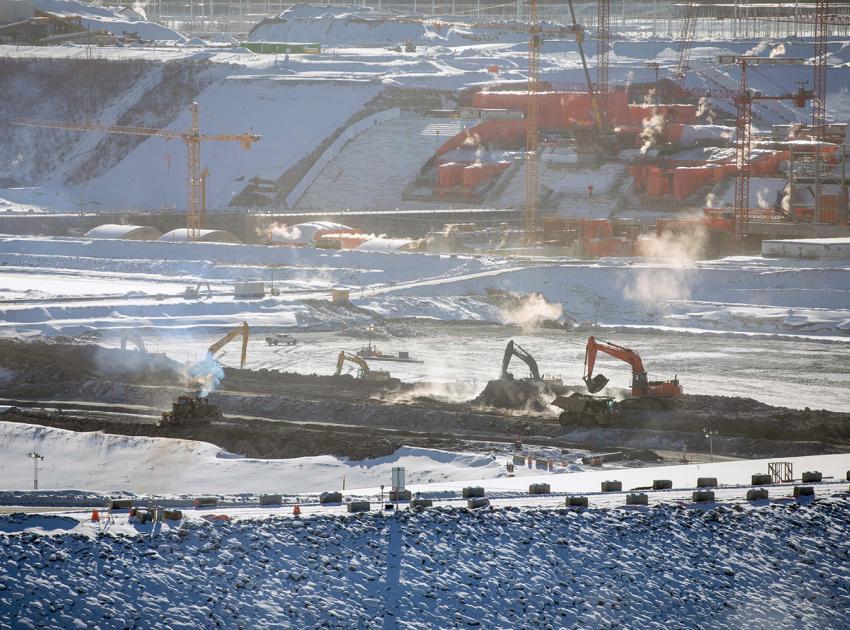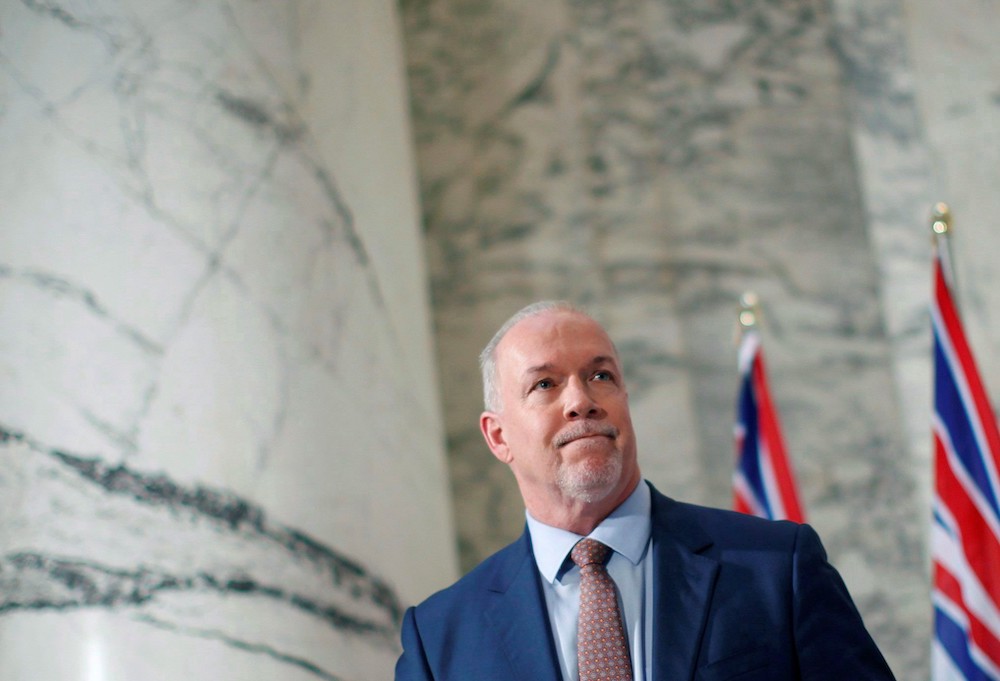Premier John Horgan is the self-anointed grand pharaoh of megaproject folly. A completely unnecessary and high-risk dam once budgeted at $8 billion in 2014 will now cost more than $16 billion due to geotechnical problems tied to trying to build on shifting shales with no bedrock.
Given that the megaproject is only half done, most experts expect at least a $20-billion price tag by 2024.
The pharaoh was alerted by the wise and experienced. Marc Eliesen, a former BC Hydro CEO, for years in his various independent reports and testimony, loudly warned about this outcome for the largest construction project in B.C. history.
“There is no upper cost limit on this project and monitoring for safety due multiple geotechnical issues is going to be so significant that it is going consume enormous budgets,” Eliesen reaffirms.
Given the evidence on multiple geotechnical troubles and gross mismanagement, any sensible person would arrive at only one conclusion: “It is called stop,” Eliesen tells The Tyee.
But that’s not what pharaoh Horgan chose to do. Last Friday, he told ratepayers and taxpayers to not worry. (And isn’t it wonderful, for a change, to have a social democratic King Tut knee deep in secrecy and unstable shales.)
Out poured the excuses faster than from a leaking dike: “No one could have imagined the global pandemic’s economic impacts,” tweeted the pharaoh.
Then the mighty one blamed former premier Christy Clark for pushing the project beyond an imaginary point of no return, proving that Horgan doesn’t understand a basic premise of modern economics. It’s called the sunk cost fallacy and it applies to personal financial decisions as well as megaprojects.
The sunk cost fallacy, boiled down, is the irrational act of throwing good money after bad.
Nor does Horgan understand how inherently risky is the business of megaprojects as illuminated by Oxford scholar Bent Flyvbjerg.
Horgan did say he is committed “to addressing the project’s challenges” to ensure British Columbians have “clean and affordable” power for the next 100 years as the province works “to meet our climate targets.”
He warned that cancelling the project would mean increasing rates by 26 per cent over the next 10 years.
The pharoah didn’t say too much about the dam’s daunting geotechnical problems, but left that work to a pile of tardy and unconvincing documents and reports.
Let’s wade through this greenwashing pool of stagnant untruths.
Horgan owns this megaproject debacle because he refused to recognize the risks in 2017 when the project had eaten up $2 billion and was already over budget.
At the time, it was already clear this monster dam, largely designed to subsidize the LNG industry, wasn’t needed and would destroy valuable farmland and violate Treaty 8 rights.
Moreover, cheaper and smaller renewable alternatives could produce more low-carbon watts with fewer ecological costs.
Horgan could have gotten a stark glimpse of the future by casting his eye towards Newfoundland’s Muskrat Falls project and Manitoba’s Keeyask dam, both by then over budget and experiencing huge delays due to lack of proper oversight and geotechnical problems.
A 2019 study laid out why we were not too deep into Site C to get out. “Careful economic analysis suggests that B.C. ratepayers may, in fact, end up paying more by the project continuing than they would if they simply paid off the debt already incurred and pursued an alternative path.”
Horgan’s claim that any debt incurred by the project must be depreciated in 10 years is baloney. According to Eliesen, amortization would occur over a 70-year period and not be a horrendous burden.
But like most pompous pharaohs, Horgan shows no signs of remorse.
Why megaprojects are so risky
Here’s why the sunk cost fallacy so often manifests itself in construction boondoggles.
The proponent of a megaproject, whether corporate or government, typically underestimates costs, overestimates revenues, diminishes environmental losses and overvalues spillover effects — such as jobs — in order to win project approval. And then they dig the hole bigger.
A pharaoh or senior group of engineers will continue to spend more cash on a wobbly pyramid to justify their earlier bad decisions. Group think is a big part of the sunk cost fallacy.
The sunk cost fallacy has undone lots of governments — see the Vietnam War. And even civilizations. When the Vikings invaded Greenland, they invested so much in creating their pastures and villages that when the weather changed, they refused to abandon their colonial megaproject, and died.
If Horgan understood the sunk cost fallacy, he’d stop Site C now, saving the province more than $10 billion. He’d then invest that sum in diverse, small community-based projects that actually get a climate bang for the buck — and if one goes sideways, it doesn’t represent a devastating hit.
But because Horgan foolishly poured $10-billion worth of concrete on unstable shales, he feels he’s obligated to spend billions more, depriving us of other solid options.

How did we get here?
Did the pharaoh consult First Nations? No.
“The premier’s decision has grave consequences for West Moberly and other First Nations,” said Chief Roland Willson of West Moberly First Nations last week.
“His government had a constitutional duty to consult us. That’s the law. It’s been the law for over 20 years. Yet the premier hasn’t so much as acknowledged our existence on this issue. Is this what he thinks of Indigenous peoples? Is this what he means by free, prior and informed consent?”
And what about Horgan’s shameless claim that this massive project is “clean”?
For 40 years, the science on dams has illustrated that clean energy from dams remains another technological illusion.
The flooding produces significant volumes of greenhouse gases including methane. Moreover, dams strangle rivers, drown forests, block fish movements, increase methylmercury pollution, displace entire Indigenous communities and violate treaty rights. And the amount of energy embedded in their construction is vast.
These costs make the very concept of “clean energy” a lie. The truth, of course, is uncomfortable. Every form of energy comes with an ecological cost.
The only people in British Columbia who still believe the propaganda that bills Site C as a “clean energy project” are senior executives of BC Hydro, a group of deluded NGOs and Horgan’s cabinet ministers.
Milburn’s damning dam report
And what about the promised review of the Site C project by civil servant Peter Milburn last July?
Well it’s a short document, a mere 40 pages, if long in the unveiling. British Columbians only got to see it four months after the provincial election when it might have guided voter’s decisions.
Milburn can’t claim to offer a truly independent analysis because he helped to set the terms of reference for the project’s oversight in 2017 while deputy minister of finance.
In his report, Milburn also admits that he “did not conduct an independent analysis in areas such as cost estimates, geotechnical issues, or construction schedules.” His report says that Milburn relied solely on 5,500 documents provided by BC Hydro.
Even so, the results are predictable if not infuriating. Eliesen, who not only headed BC Hydro but also Manitoba Hydro and Ontario Hydro, explains that Milburn’s report underscores what the critics have been saying all along in The Tyee for four years.
“It confirmed that the project is being mismanaged and the BC Hydro doesn’t have the capacity to manage a project this size because they haven’t built a dam of this size for 40 years,” said Eliesen.
“It confirmed that one of the cardinal rules is that you don’t appoint people in a conflict of interest to a public accountability board. And BC Hydro completely underestimated the geotechnical risk.”
Here are a few classic understatements from Milburn’s report that should disturb the heart rate of every British Columbian:
“Half of the project advisory board members performing due diligence on the project also belong to the BC Hydro board providing direction for the project. These overlapping roles can make independent oversight challenging.”
“With the benefit of hindsight, we can see BC Hydro miscalculated the potential impact of the geotechnical issues.”
“Furthermore, based on discussions with BC Hydro, the complexity of the project, and the magnitude of the project risks and related contingency, the overall size of the risk management organization on Site C appears to be understaffed.”
“Based on information gathered during this review, it is our opinion that currently there are an insufficient number of experienced personnel within BC Hydro at the time of writing of this report. Construction advisors also hold this view. “
Eliesen offers his own summary: “The project is mismanaged and no more review is going to change things. The arrogance of senior management is utterly incredible, and they are running the show.”
Last year, I dared Milburn to acknowledge the extensive work of Oxford scholar Bent Flyvbjerg on the dismal economics of megaprojects in his report.
But Milburn didn’t go there. If he had, he might have included in his report uncontestable research that says megaprojects promise jobs and prosperity but mostly deliver complexity and fragility. Nine out of 10 megaprojects (high tech infrastructure) will never deliver a return on their initial investment.
Moreover, a survey by the Oxford University Saïd Business School found that 274 dams built since 1934 routinely went over budget, and not just by a little amount. On average, they went 96 per cent higher than their approved budgets. The Site C scandal proves this rule again.
Flyvbjerg also identified the root of megaproject failure and mismanagement: “It’s the people on the project who are the biggest risk.”
At this point, British Columbians have but one urgent duty. At every opportunity they must remind Horgan and his MLAs that there is only one democratic option for Site C: cancel the project now, restore what has been destroyed and open the books for a full public inquiry.
Anything else is state-sanctioned insanity. ![]()
Read more: Energy, BC Politics
















Tyee Commenting Guidelines
Comments that violate guidelines risk being deleted, and violations may result in a temporary or permanent user ban. Maintain the spirit of good conversation to stay in the discussion.
*Please note The Tyee is not a forum for spreading misinformation about COVID-19, denying its existence or minimizing its risk to public health.
Do:
Do not: